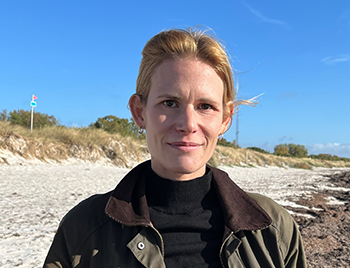The Baltic Sea Flood – the forgotten storm surge that can provide lessons for the future
The Baltic Sea Flood 150 years ago, which swept away entire communities and caused several hundred fatalities, is almost forgotten today. Nonetheless, the Baltic Sea Flood is one of the worst natural disasters ever to strike the southern Baltic Sea. However, using lessons learned from history and new knowledge about storm surges in the wake of climate change, researcher at the Faculty of Engineering (LTH) at Lund University want to make us better equipped for the extreme weather of the future.
Jessika Sellergren – Published 16 November 2022

Caroline Hallin's research has focused on the Baltic Sea Flood for many years. She is a coastal engineer and researcher in water resources engineering at LTH and examines why storm surges occur and how our communities can protect themselves against future extreme water levels.
Collective memory is part of emergency preparedness
Storm surges are temporarily raised water levels that can lead to flooding. A rise in sea level is linked to meteorological factors, but climate change is also contributing to higher water levels and the increasing frequency of storm surges.
However, there needs to be a greater awareness in order to prevent storm surges and protect society from flooding, comments Caroline Hallin.
“In this context, knowledge about the Baltic Sea Flood is critical – to remind us of the consequences of the fatal storm surge and the lessons learned by the affected communities.”
Caroline Hallin calls this the collective memory of the Baltic Sea Flood, which she considers an important part of risk awareness and emergency preparedness.
“Bringing to life the memory of what happened in 1872 and why it happened is a necessity if we are to manage better the next time a storm surge engulfs our coastal communities,” says Caroline Hallin.
The Baltic Sea Flood could happen again
It is highly probable that a storm surge like the Baltic Sea Flood could strike the southern Baltic Sea again.
“The risk of flooding is increasing as climate change is causing sea levels to rise, and there is also housing development close to the coast,” says Caroline Hallin.
Because, according to Caroline Hallin, we have not been very good at using the collective memory and knowledge of historical storm surges, which has led to the exploitation of risk-prone areas in southern Sweden.
“Since this extreme storm event, the coast's flood-prone communities have expanded, adding thousands of houses that risk being flooded if a similar event happens again. If we had learned from the earlier storm surges, we would simply not have built there,” says Caroline Hallin.
Natural flood protection
What we have learned from previous storm surges is that nature itself accounts for several good forms of flood protection – such as sandy beaches and sand dunes that can deflect wave energy and protect the areas behind against flooding.
“Some coastal areas have natural flood protection through sand dunes, but in other places, there is a need to build embankments, and in some, it may be necessary to build new embankments,” says Caroline Hallin.
Already in 1872, when the Baltic Sea Flood occurred, there were embankments made of eelgrass that protected the settlements on the Falsterbo peninsula.
”But the embankments were not high enough to protect against the Baltic Sea Flood. The storm surge breached the dikes, and almost all of the Falsterbo peninsula was flooded. But thanks to the fact that the old settlement was located at the high points of the terrain, the area was less severely affected. The greatest damage occurred on Scania's east coast, where the large waves smashed the houses and harbors in the fishing villages,” says Caroline Hallin.
Knowledge review of storm surges
In order to manage the collective memory of the Baltic Sea Flood and combine it with knowledge about storm surges and floods, Caroline Hallin and her research colleagues have published a knowledge review on the subject.
“We hope that the report increases understanding of storm surges, why they occur and how we can better protect ourselves when they happen again – so that history teaches us to build a robust society for the future,” says Caroline Hallin.

Caroline Hallin
Caroline Hallin is a coastal engineer and researcher in water resources engineering at LTH.
Profile in the Lund University research portal
About the Baltic Sea Flood
The Baltic Sea Flood occurred on 13 November 1872 and was a storm surge that measured 3.5 metres above sea level. The storm surge led to several coastal communities in southern Sweden, Denmark and northern Germany being flooded and swept out to sea. The Baltic Sea Flood caused the deaths of 300 people and in Schleswig-Holstein in Germany alone 15,000 people were made homeless.
Film about the Baltic Sea Flood
In this film Caroline Hallin talks about the Baltic Sea Flood and storm surges (in Swedish):
Backafloden – den bortglömda stormfloden som kan lära oss för framtiden – Lunds universitets YouTube
Knowledge review of storm surges
To increase knowledge about storm surges, Caroline Hallin has produced a knowledge review of methods to identify extreme sea levels and develop solutions to manage them. The authors of the report are – besides Caroline Hallin – Helena Alexanderson, Magnus Larson and Timothy J. Ley from water resource engineering, quaternary geology and building and environment technology. The knowledge review was funded by FORMAS.
The report about storm surges in the Lund University research portal (in Swedish)
